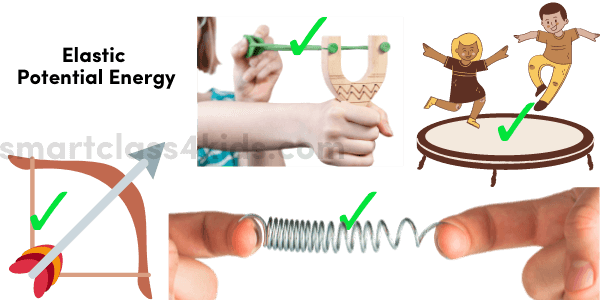An Introduction to Potential Energy
What does “Potential” mean?
Let’s first understand the meaning of “Potential”. The root word of potential in Latin is potentialis, from potentia ‘power’, from potent- ‘being able’, from the verb posse. (source)
Potential means “something that can develop or become actual”. In simple words, potential means “possible”. Example: Working hard increases the potential for success. Over speed increases the potential for accidents.
What is Energy?
Energy is the ability to do work. Here work means when a force is applied on an object to cause movement or displacement in the direction of the force. The work is calculated by multiplying the applied force by displacement.
Work = Force x Displacement
Also Read: Different Types of Energy
What is Potential Energy?
Potential energy is the stored energy in an object. This stored energy occurs due to its position or change in shape.
For example, when we lift a ball, it stores potential energy due to its position change. Similarly, when we compress a spring, it stores potential energy due to its change in shape and as soon as we release the spring, the stored potential energy converts into kinetic energy.
In simple words, the potential energy of an object refers to the object’s “potential” to do something.
Some examples of Potential Energy
- Drawing a bow
- Stretched rubber band
- Compressing a spring
- Roller Coaster
- Lifted hammer
- Cliff rock
- Fruits on the tree
- Batteries
- A sled at the top of a snowy hill
- A kid at the top of the slide
- Water at the top of the waterfall
What Is Potential Energy Measured In?
What are the types of potential energy?
Mainly there are three types of potential energy:
- Elastic potential energy,
- Gravitational potential energy,
- Chemical potential energy
Elastic Potential Energy

Elastic potential energy is the energy stored in objects that can be either compressed, stretched, or twisted by applying force. As long as the force is not released, the energy is stored in the object.
Springs, rubber bands, an arrow drawn into a bow, trampolines, and bungee cords are some examples of elastic potential energy.
The amount of elastic potential energy stored in an object depends on how much it can be stretched or compressed. The more an object can be stretched or compressed, the more elastic potential energy it stores.
Examples of Elastic Potential Energy
- An archer’s stretched bow
- Coiled Spring
- Bouncing ball
- Bungee cords
- Rubber band
- Trampolines
- Slingshot
- Sponges
Gravitational Potential Energy

Gravitational potential energy is stored in an object when held in a vertical position or height. This energy occurs due to the gravitational force of the Earth pulling the object down.
The amount of gravitational potential energy stored in an object depends on its height and mass.
There is a direct relation between gravitational potential energy and an object’s mass and height. Gravitational potential energy increases as mass and height of an object increases.
Examples of Gravitational potential energy
- Cliff rock
- Fruits on the tree
- A sled at the top of a snowy hill
- A kid at the top of the slide
- Water at the top of the waterfall
- A giant ball of a demolishing machine
- A yoyo before it is released
- Flying airplane
Chemical Potential Energy

Chemical potential energy is the energy stored in the chemical bonds (bonds of atoms and molecules) of a substance. Chemical potential energy occurs when energy is released during a chemical change.
Chemical potential energy depends on mainly three factors:
- The mass of an object
- Temperature
- Nature of the chemical-specific heat
Examples of Chemical Potential Energy
- Fireworks before they are launched
- Charged batteries
- Charcoal burning
- Food that we eat
Which of the following is an example of potential energy?
- The food we eat
- Stretched spring
- River
- Walking or running
- Flying airplane
- Parked car
- Bullet from a gun
- A book on the table
- A charged battery
- Stretched rubber
- Rollercoaster
- Bouncing ball
- Compressed spring
- Moving car
